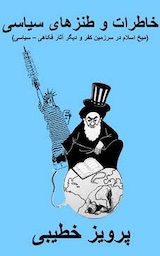Cartoon by Shadi Ghanim
A new U.S. sanction reminds us that Iran’s Revolutionary Courts aren’t real ones
By Jason Rezaian
The Washington Post: On Thursday, Secretary of State Mike Pompeo delivered a major speech on the dire state of human rights in Iran. The list of the regime’s abuses of the Iranian people is long and well-documented — even if American prescriptions for changing Tehran’s behavior seem unlikely to achieve the promised effect.
Still, there was one policy move that grabbed my attention: the sanctioning of two judges of the Islamic republic’s Revolutionary Court. One of them — Abolghassem Salavati — presided over the case against me while I was held, without due process or legal protections, for 18 months in Iran’s Evin prison.
“Salavati has sentenced hundreds of political prisoners,” Pompeo said in his remarks. “He’s the go-to guy. He sentenced journalists and human rights activists to prison — or worse, to death. He’s a tool of the regime’s oppression, not an impartial friend of justice. And today he’s now sanctioned by the United States of America.”
Many Iranian officials — especially senior members of the judiciary — are largely unable to travel abroad, due to a combination of E.U. travel restrictions and Interpol “red notices,” so the sanctions are unlikely to cause new difficulties for Salavati or the other designated judge, Mohammad Moghisseh. But the move sets an important precedent.
The U.S. government has long been opposed to sanctioning or levying other punitive measures on members of another country’s judicial system. But as a senior State Department official told me, they used available evidence to prove that Moghisseh and Salavati were not real judges since they do not act independently from the state security apparatus.
“Judges on these Revolutionary Courts, including Salavati, have acted as both judge and prosecutor, deprived prisoners of access to lawyers, and intimidated defendants,” said a Treasury Department statement announcing the sanctions. Both judges, it said, “oversaw the Iranian regime’s miscarriage of justice in show trials.”
That description certainly tracks with my experience in Salavati’s courtroom. Salavati, who presides over Branch 15 of Tehran’s Revolutionary Court, is known as the “judge of death” and the “hanging judge” for the hundreds of political prisoners he has sentenced to death over the years.
As I recount in detail in the book I wrote about my imprisonment, Salavati made absolutely no pretense that he was impartial. He even threatened to execute me in the pretrial phase. He and the prosecutor were present during all of my encounters with my own counsel. There were no witnesses in my trial except for me, and prosecutors produced no evidence to support any of the claims against me.
Simply put, it was not a real court proceeding.
My mother also was permitted several audiences with Salavati as she attempted to obtain greater access to me during my imprisonment and to advocate for my rights. She is the rare American who has come in repeated contact with Salavati. The fact that she was a licensed and trained psychotherapist gives her additional insight.
Her assessment was that this person, who wielded incredible power over the lives of the accused in his court, was in no way equipped to handle the task. He displayed manic behavior that bordered at times on the aggressive. She confirmed the whispered observations of other lawyers that Salavati showed clear signs of being chemically sedated while on the job.
In sum, not someone fit to occupy the bench.
“The United States will not be a bystander to ongoing oppression and injustice in Iran,” said Treasury Secretary Steven T. Mnuchin in a statement. “This Administration is targeting those in the regime who seek to censor protestors, persecute religious minorities, and silence the Iranian people.”
I welcome the United States’ decision to address these abuses of power.










"I welcome the United States’ decision to address these abuses of power." Jason Rezaian
Threrefore, Jason agrees with Prince Reza Pahlavi.
Javid
Did jason joon get his $50M compensation from ayatoola ali khayehmany yet?